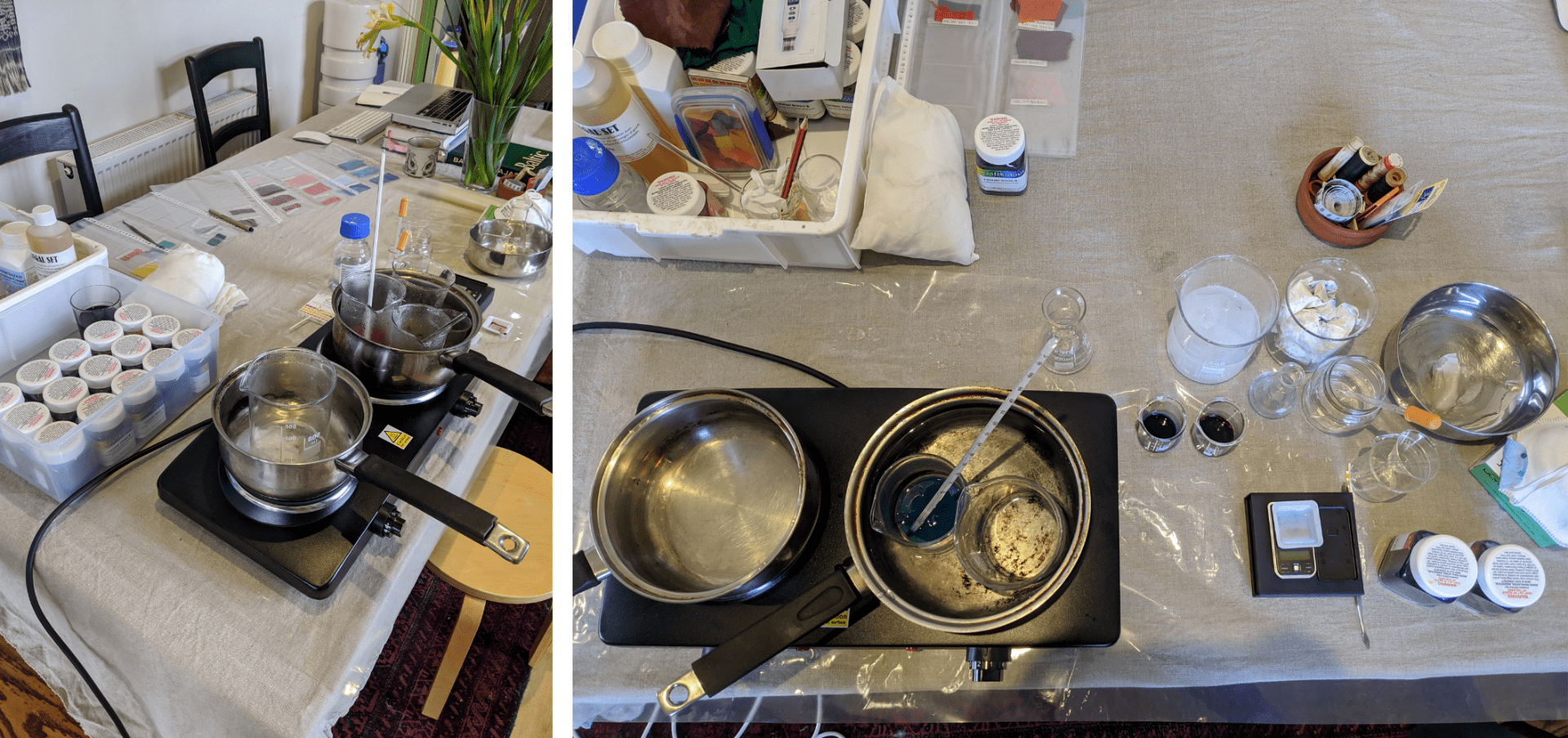
WFH as a Textile Conservator
Victoria Thomas is a textile conservator at Grimwade Conservation Services, the commercial arm of the Grimwade Centre. In this recent article, republished here from Gabberish, she explores what it’s like to be a conservator working from home during Melbourne’s COVID-19 lockdown. She looks at how one can still carry out some of the complexities of the craft in a home (kitchen!) lab and (re)discover old and new techniques.
Turn! Turn! Turn! Has been in my head a lot while working from home. I’ve been watching a maple tree in my street that doesn’t seem to know that time has stopped, dutifully turning its green leaves red in April and May, and now baring its branches for the winter.
Time is, of course, ticking on, without the punctuations of daily work routines that we’re used to.
Please don’t think I’m profound. Of course, the main reason that The Byrds have been in my head is entirely birdbrained. As I spend my days stirring samples of silk in dyes baths, my own melodic narration kicks in:
To everything (STIR! STIR! STIR) there is a season. A time to be born, a time to DYE.
If it wasn’t entirely clear: while working from home as a textile conservator, I’ve done a lot of dyeing (and not had a lot of social interaction).
For a lot of textile conservators, dyeing every week is not that uncommon. That said, the process can be lengthy, often taking up the better part of a working day – usually, we’re dyeing support fabrics to match the colour of an existing, historic item, which can take multiple batches and baths to get just right. Some conservation studios rely on dye reference libraries, built over time, to condense the process; while others, like us, for instance, have adapted modern textile colourants in paint form to speed things up. The effect is the same, and it’s archival, though it sometimes pains the traditionalist, slow-process devotee in me.
It’s interesting – a lot of people’s conception of art conservation (if they have any at all) is, indeed, of a slow-moving, incredibly time-intensive and precise process. It is that, and it’s an essential part. It’s part of the allure and the romance, and also part of a lot of safe and effective restorations.
But conservation is also a job, one which has its deadlines, time and budget constraints like any other. It’s a job now, too, like many others, which has been adapted to fit a work-from-home model.
And so, away from the bench, and on to the kitchen table.

The concept of working from home for conservators who are not actually able to do much conservation has presented one significant benefit, and something we don’t actually always get, which is time. Specifically, time for research and intensive professional development. For me, the … work-from-home period presented a chance to condense years of institutional knowledge into what, at the time, was going to be three to four weeks, and start to develop a useful dye reference library.
So, at the end of March, while a lot of workers carted home monitors, keyboards and desk chairs (got that too, fear not, ergonomists), there we were stacking up scientific scales, a hot plate, beakers and lab wear into the back of my car, heading home for what turned out to be a lot of time.

The process is pretty straightforward now, and it’s become almost meditative. The night before a dye day, I’ll soak the fabric in a pH-buffered water bath (I’m using protein dyes, which work only at a specific acidity). In the morning, I set up the hot plate with beakers and thermometers, measure out and add the dye and let it go until the dye exhausts (until the colour from the liquor bath fully transfers to the fabric, and the bath runs clear).
It’s extremely satisfying when it works. When it doesn’t, it’s also been a fun challenge to find out why. Sometimes it’s for slightly annoying reasons like a miscalibrated pH metre, or too-old-dye-solutions. Other times it’s been due to the fibre content, thought to be 100% silk, being perhaps-not-quite-100%.
The research that has gone along with it has also broadened hobbyist avenues. A casual natural dyer before, I’ve now gone down historic-dye-recipe rabbit holes, and trying out old techniques like solar dyeing with foraged plant material and kitchen scraps.

When we went back to work part-time in June, I found my reference library useful; I matched the colour of a missing piece from a silk collar right away. It’s good to know it was time well spent. Now all I want to do is go home and dye.
Read more about home conservation during lockdown, with Victoria’s colleague Peter Mitchelson on Gabberish and the University’s Museums and Collections News.
For those that are interested in the painstaking art of conservation, you can watch it happen with some satisfying timelapse videos of conservation efforts from State Library New South Wales, the British Library and The Met.